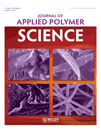Synergistic effect of phosphorus-containing nanosponges on intumescent flame-retardant polypropylene
Abstract
A novel nanosponge (NS) was synthesized via the crosslinking of β-cyclodextrin with epoxy resin. Subsequently, a phosphorus-containing nanosponge (P–NS) was prepared by the absorbance of resorcinol bis(diphenyl phosphate) into the NS, and it was used as a synergistic agent of intumescent flame retardance in a polypropylene (PP)/melamine pyrophosphate/pentaerythritol composite. The synergistic effect between P–NS and the intumescent flame retardant (IFR) was investigated by thermogravimetry, limiting oxygen index (LOI) testing, vertical burning (UL-94) testing, cone calorimeter testing, and scanning electron microscopy (SEM). The results show that P–NS significantly improved the flame retardancy of the PP/IFR composite. When 3.0 wt % P–NS replaced the same amount of IFR in the composite, the LOI value increased from 29.0 to 32.5%, the UL-94 rating was enhanced from V-1 to V-0, and the peak heat release rate decreased substantially from 343 to 235 kW/m2. Simultaneously, the total heat release and mass loss rate decreased dramatically. Furthermore, the SEM results show that the quality of char formation of the PP/IFR/P–NS was superior to that of the PP/IFR composite. © 2012 Wiley Periodicals, Inc. J Appl Polym Sci, 2012




